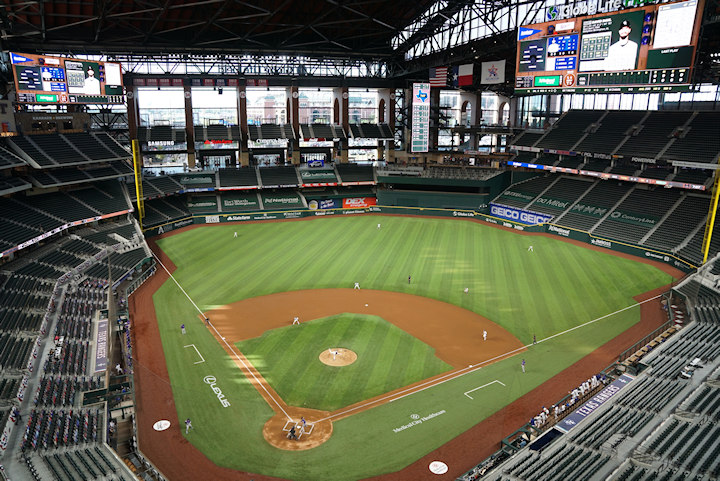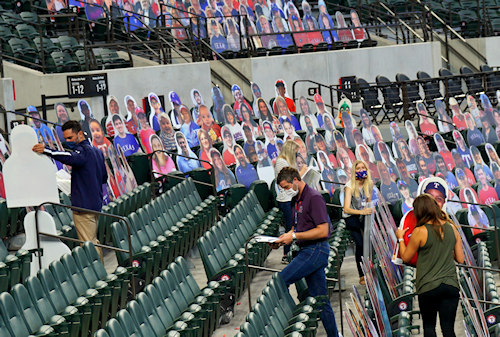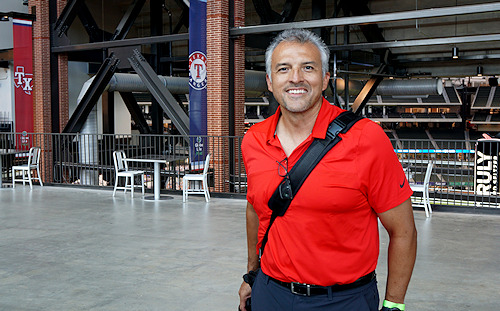
Text and photos by Joe Mock
All rights reserved
ARLINGTON, TEXAS For the Texas Rangers, July 24 was to be a monumental day. After four years, 6 million manhours of labor and construction costs of $1.2 billion, Opening Night for their new home ballpark had arrived.
But even with a 1-0 win over Colorado in the first game at Globe Life Field, it was somewhat of a bittersweet event for the franchise.
“There will be some level of satisfaction and accomplishment for everybody in the organization who’s put in so much time and effort to bring this facility to life,” says Rob Matwick, the team’s Executive VP of Business Operations. “But not having guests here to enjoy it is a disappointment.”
He’s in his 35th season of working in big-league baseball, but the events of 2020 are unprecedented. “It’s like no other season I’ve ever experienced.”
Major League Baseball started the regular season on July 23 and 24 with no fans in the stands, so the Rangers were in the same situation as the other 29 teams. But they were the only ones with a gleaming new stadium to show off.
In the fan-less opener, starter Lance Lynn picked up the win as the two teams managed only three hits apiece. The game’s only run happened in the 6th when Danny Santana and Rougned Odor each doubled. The Rockies’ lead-off batter David Dahl collected all three of his team’s hits.

Gameday
Chuck Morgan, the team’s Executive VP of Ballpark Entertainment and Production, is responsible for coordinating the gameday experience. While promising a “full entertainment package” for Opening Night, he recognizes that nothing is operating like a normal season. “It’s the hand we’ve been dealt.”
During the pre-game introductions of Rangers players, an assemblage of cheering fans, each in a small Zoom-style box, appeared on the videoboards. When it came time for the National Anthem, Country star Charley Pride sang live, but from the park’s concourse.
The ceremonial first pitch was delivered virtually, with Texas Governor Greg Abbott making the toss from Austin. The actual first pitch by Rangers starter Lance Lynn is shown at the top of this page. When Lynn went on to strike out lead-off batter David Dahl, piped-in cheers rose from the stadium’s speakers.
In the 3rd, when Ranger Nick Solak was out on a close play at first, the crowd sounds went from a cheer to a groan. Nice touch.
The first hit in the new park was a single by David Dahl in the top of the 3rd, his first of three. The only audible reaction was the applause from the Rockies dugout. When the Rangers scored the first run of the game on an RBI double by Rougned Odor in the 6th, the videoboard showed a live shot of cheering fans in the “arena” dining area in the Texas Live! development next door to the ballpark.
In the tense top of the 9th in the one-run game, the crowd sounds seemed to pulsate, erupting in cheers as Rangers’ pitches were called strikes. It was one of the most realistic crowd noises of the evening.
A few kinks need to be worked out. When Lynn accomplished five of the first seven outs on strikes, the videoboard posted “4 Strikeouts” in huge letters.
For appearance’s sake
During much of a televised game, the area behind home plate is in the frame. Several MLB teams invited fans to submit photos that could be converted into a cardboard version of themselves, and those were placed in seats behind the backstop.
| Doppel-Rangers |
 |
| In preparation for Globe Life Field’s Opening Night, Rangers employees install “Doppel-Rangers” on the seats behind the backstop. |
The Rangers’ approach was to encourage fans to make donations to the team’s charity, The Rangers Foundation, when submitting their photos. Using a clever play on the term doppelganger, almost 2,800 of these “Doppel-Rangers” were propped up on seats behind home plate on Opening Night.
Even with no fans to see the videoboards, Morgan kept the player highlights and replays coming. “I care about the players. I want this to be special for them.”
The main board high above right field also includes some advanced metrics, like the induced vertical break and horizontal break of pitches and exit velocity and angle on batted balls.
Sounds of the game
“Not having fans in the ballpark presents the challenge of how to make it sound like there are 40,000 people having a good time at the ballgame,” says Morgan.
To compensate for this, Michael Gruber, the team’s DJ – a new concept at Rangers games this year – poured over tapes of games from recent seasons. He pulled audio clips that correspond with any conceivable situation that might occur during a game. Armed with over 100 files of crowd noise, he filled Globe Life Field with sounds that made the players feel at home, and that sounded realistic to fans watching on TV.
“We have the basic crowd murmur from when the gates would open,” explains Morgan. “As it progresses through the evening, that gets a little louder as we pretend the stands are filling up.”
He adds that there’s even the bellowing of a hot dog vendor that can be added to the mix from time to time.
What if a close call doesn’t go the Rangers’ way, or the opposing pitcher throws to first base to hold a runner close? Are there sound files of fans booing? “MLB wants us to keep everything positive,” says Morgan. “If an actual crowd wants to boo, that’s one thing, but there’s something that doesn’t feel right about an employee of a team pressing a ‘boo button’ at an umpire or opposing player.”
Levi Weaver, The Athletic’s beat writer for the Rangers, says the piped-in sounds “really do help. At intra-squad games here the last couple of weeks, there was no sound, and it was weird. When a home-run ball came off a bat, it sounded like a 9-millimeter gun shot.”
Players didn’t mind
Concerned that the Rangers’ players would be less motivated when not playing in front fans? Don’t be.
“To be honest with you, I was excited to play the game,” starting pitcher Lance Lynn related afterwards. “I was jacked up to play baseball. When you sit at home for three months and don’t know if you’re going to play and there’s a global pandemic going on and you need to go back and do your job and play a game for a living and fans get to watch (on TV), you get excited.”
With a run-on sentence like that, his excitement must’ve carried over into the postgame interviews.
“So I was jacked up. I wanted to win,” he added.
By design
Like the Rangers’ former home, Globe Life Park, and the Dallas Cowboys’ AT&T Stadium two blocks away, Globe Life Field was designed by local architecture firm HKS.
| Designer |
 |
| HKS Principal Fred Ortiz at Globe Life Field |
Fred Ortiz, Principal at HKS, says the delay in the start of the season “has allowed the venue to take shape and be better prepared for Opening Day.”
He notes that when fans are allowed to attend games, “the ratio of square footage to capacity is greater here than at other parks.” That will make it much easier to practice social distancing, especially in areas like the concourses.
“It is home-like here. It’s very comfortable and welcoming,” Ortiz adds. As gametime for the opener approached, it was 95 degrees outside and 72 degrees inside the new ballpark. The retractable roof and air conditioning are welcome indeed, as the Rangers have endured more 90-degree-plus gametime temperatures in the last 25 years than any other team in the Majors – and more than double the second-hottest locale (St. Louis).
On the air
Those broadcasting the Rangers Opening Night game encountered some pluses and minuses in the unusual circumstances.
Emily Jones typically reports from the dugout for Fox Sports Southwest’s telecasts, but that’s not allowed during these social-distancing times. “The hardest part for me is not being able to connect with the players,” she says. “So what we are focusing on right now is letting the viewers at home get a feel for what the new ballpark is like.”
And with no fans present, she adds “it sure is easier navigating the park.”
Eric Nadel, the radio voice for the team since 1979, says the environment seems “very weird, as we are in a new stadium so we don’t have any idea what ‘normal’ looks and sounds like.”
He adds that the strangest situation will be broadcasting road games while looking at TV monitors from the booth at Globe Life Field, all part of MLB’s protocols for this season. Hence the Rockies’ broadcast team did Opening Night while back in Denver.
Nadel adds that “seeing players with masks, of course, is odd, and seeing Rangers relief pitchers sitting in picnic areas designed for fans seems goofy, but everything this year will be weird. We’ll just describe what we see and enjoy the adventure.”
Following at home
With fans not allowed in the stands, broadcasts of the games are more important than ever.
Frank Jackson, 70, of the Oak Cliff neighborhood of Dallas, has followed the Rangers closely since the ‘70s, almost exclusively on radio. So he’s keenly aware of how the games sound differently now.
“In radio broadcasts, there was always some sort of crowd hum or buzz in the background all through the game. Now there are huge dead spots punctuated by walk-up music or other cheerleading snippets to get the crowd stirred up — even though there’s no crowd.
“Also, when someone on the opposing team does something, like hitting a home run, there is dead silence,” he’s noticed. “Normally, there would be some sort of negative reaction, modest or loud. You can even hear the sound of a few people clapping, presumably the sound carrying up from the visiting team’s dugout.”
Jackson appreciates the Rangers’ radio tandem of Eric Nadel and Matt Hicks. “Thankfully, they haven’t missed a beat despite the long layoff. They’re just as informative and entertaining as ever.”
Life in a bubble
For the visiting team, roadtrips are definitely not the same as in past years. “It’s a lot different,” explains Paul Egins, the Travel Director for the Rockies, the Rangers’ opponent in the Opener.
“For one thing, on all of our travel on buses or planes, we have to provide a passenger manifest to Major League Baseball. That includes where everyone sat.” That’s so that “contact tracing” can be done if a member of the travel party tests positive for COVID-19.
And because players are prevented from sitting close to each other on buses to the airport or ballpark, more buses are required.
All of this is described in great detail in the MLB Operations Manual that was created for 2020’s unprecedented season. “It’s quite thick, and the players were all told they had to become familiar with it,” he adds.
Not all of the new protocols are bad news for Egins. “Some of it means less work for me. For instance, since there are no tickets, I don’t have to keep up with the players’ requests for (guest) passes. I used to spend about an hour each day on that.” And because family members can’t be at the road games, he doesn’t have to deal with the hassles of accommodating them.
50% is far better than nothing
The good news for Rangers fans is that the two MLB teams in Texas may be among the first to allow fans to attend games. Because the state is considered to be “open,” athletic events are permitted as long as attendance is limited to 50% of capacity.
“MLB has told us that we can’t permit fans for our first two series,” Matwick explains. “We are still hopeful. We are still planning. Our job is to be ready.”
This article was also published in USA TODAY Sports Weekly.